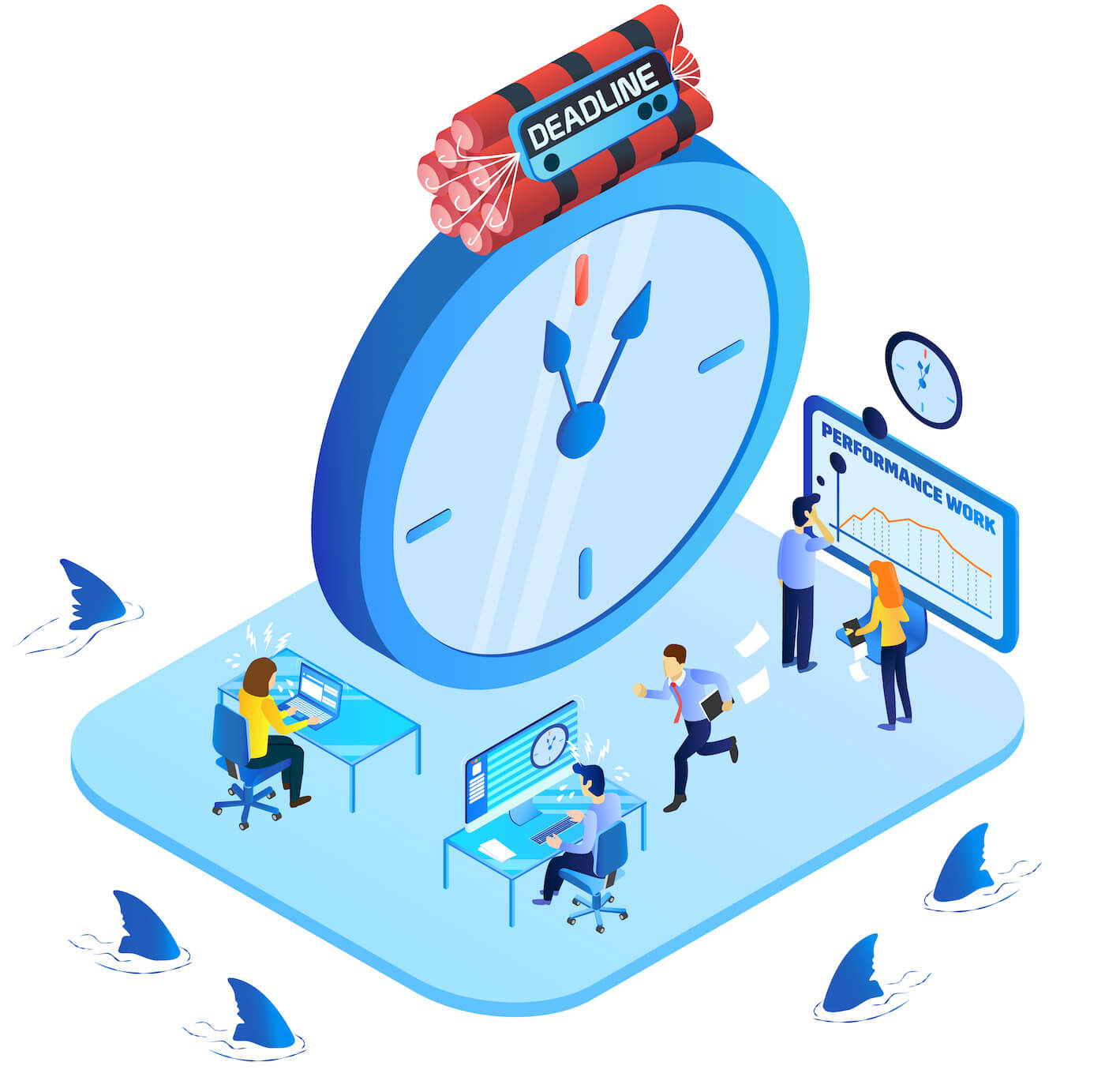7 Ways Employee Monitoring Software Can Prevent Employee Burnout
Are you an employer watching your employees burn out from months of work-related stress? Have you noticed that long hours, difficult tasks, and deadlines seem to be a regular part of the working day, regardless of whether the workload has increased?
If so, you’re not alone.
Employee burnout is becoming increasingly common in today’s competitive business environment–but it doesn’t have to stay this way! With employee monitoring tools like time-tracking software and activity management solutions, employers can reduce employee stress while motivating their teams— all at once.
In this blog post, we’ll cover the basics behind stopping burnout with employee monitoring software so that no person has to suffer an office meltdown again!
What is Employee Burnout?

Employee burnout is a state of emotional, physical, and mental exhaustion that occurs when employees are subjected to excessive stress and demand over an extended period of time. It is a chronic condition that can affect an individual’s performance, productivity, and overall well-being.
Employee burnout usually manifests as health or psychosocial symptoms. Some common burnout symptoms include exhaustion, cynicism or detachment, reduced productivity, increased absenteeism, and decreased job satisfaction. Burnout physical symptoms can include headaches, back pain, and sleep disturbances.
Burnout can be caused by various factors, including job stress, a lack of control over work tasks or schedules, unrealistic work demands, a toxic work environment, and a lack of support from coworkers or management. Additionally, individuals who are highly committed to their work and have a strong desire to succeed may be more susceptible to burnout.
Recognizing the Physical Symptoms of Burnout
Unfortunately, workplace burnout is very common. According to a survey conducted by Gallup in 2021, 76% of employees reported experiencing burnout at least sometimes, while 28% reported feeling burned out “very often” or “always.”
Here are some physical symptoms of burnout to look for in your workplace. Note that these symptoms might last longer than normal compared to individuals who have worked heavily in a short period of time or are sick.
- Fatigue and exhaustion: Employees report feeling physically and emotionally drained.
- Headaches: Employees repeatedly have tension headaches or migraines, which impact their work and aren’t normally this disruptive even if the condition is chronic before working at your office.
- Sleep disturbances that impact job quality: Employees show physical signs of lacking sleep, including lateness or discussing difficulties falling asleep or staying asleep.
- Increased illness: Increased sick days may indicate that chronic stress leading to burnout impacts their immune systems or life management.
If these signs are presented in your workplace, addressing the issue is important. The employee may not be burned out due to workplace demands, but addressing the issue will help get to the bottom of it.
Employers should consider the organization’s work-life balance, provide resources for stress management, and encourage open communication and support within the workplace.
It can be nearly impossible to spot employee burnout without tracking behavioral trends. The best way to prevent employee burnout is by implementing employee monitoring software that helps monitor employee productivity and alerts managers if fatigue or a lack of focus is detected.
7 Ways Employee Monitoring Software Can Prevent Burnout
Employee monitoring software is useful for employers to ensure that their business operations are running smoothly and that their employees are working efficiently. It can also spot trends of burnout or overwork by monitoring productivity and performance metrics.
By using monitoring software, employers can gain valuable insights into their employees’ work habits and identify areas to improve productivity and efficiency.
Identifying Areas of High Workload
Through its productivity tracking features, employee monitoring software can help identify areas where employees spend too much time, which may indicate a high workload. By analyzing this data, employers can then take steps to redistribute workloads or provide additional resources to reduce stress and prevent burnout.
Encouraging Breaks and Self-Care During Work Hours
We’ve all been there – feeling overworked, overwhelmed, and exhausted. But interestingly enough, taking breaks during work hours could boost productivity.
Allowing time for self-care and leisure activities throughout a workday can help reduce stress, improve mental clarity, and increase energy levels. And the best part? It doesn’t have to be anything extravagant or time-consuming. A quick walk around the block or a few minutes of stretching can make a huge difference in your feelings.
Employee monitoring software can encourage more breaks during work hours. Use it to track how long employees spend working without a break. Employers can use this information to remind employees to take breaks, which can help reduce stress and prevent burnout.
Providing Feedback and Coaching
Employee monitoring software can provide data on employee performance, such as how long it takes to complete a task or how frequently they make mistakes. This data can provide targeted feedback and coaching to help employees improve their performance and reduce the risk of burnout.
Use the software to establish baseline performance to gauge good or bad performance.
Supporting Work-Life Balance
Monitoring software can help employees and employers identify patterns of work that interfere with their personal life. By identifying these patterns, employers can work to implement more flexible work schedules or other strategies to promote work-life balance, which can help reduce burnout.
It’s important to note that while employee monitoring software can be helpful, it should be used in a way that is respectful of employee privacy and consistent with ethical practices. Employers should communicate clearly with employees about how monitoring software will be used and the benefits that it can bring.
Set Clear Expectations And Goals For Employees To Make Sure They Understand Their Role
It’s important to ensure employees feel comfortable asking questions and seeking guidance if they need clarification on their roles or objectives.
By providing a clear roadmap of employee expectations and job roles, employees are more likely to take ownership of their work and feel invested in the business’s success. Communicating goals and expectations can improve performance, increase motivation, and promote accountability.
Establish or renegotiate these expectations using monitoring software.
Encourage Collaboration And Team Building Activities To Reduce Stress Levels
Collaborating and team-building activities can help to reduce the stress levels in your workplace. Whether it’s a group brainstorming session or an afternoon of team-building exercises, working together on common goals and projects can help you to relax and destress. Plus, bonding with your colleagues in a fun and meaningful way can greatly improve overall morale and productivity.
So why not suggest a team-building event to your employees? You might just find that a little bit of teamwork is all it takes to shake off those feelings of stress and burnout.
Offer Flexible Working Hours Or Working From Home Possibilities For A Healthy Work-Life Balance
Flexible work or working from home can be a great way to help reduce burnout among employees. Allowing staff to structure their days and work hours around when they are most productive helps them stay energized, enthusiastic, and motivated about their work.
Remote work also means that employees don’t have to spend time commuting or preparing for work, helping to keep the work-life balance.
Workplace trends are moving away from the strict structure of the 9-5 as more research suggests that a happy employee is a productive employee. Allowing employees the freedom to maintain a healthy work-life balance is key to that happiness.
Why You Should Care About Employee Burnout

Burnout isn’t something to take lightly. Burnout is a real problem in the workplace and can have long-term consequences for both employees and employers.
If allowed to fester, subpar work performance, turnover, and even legal complaints could arise due to burnout. A study by the American Institute of Stress found that workplace stress costs U.S. employers an estimated $300 billion annually in lost productivity, absenteeism, and healthcare costs.
On top of this, employee burnout can have health consequences, and if you care about your employees, you should pay attention to preventing negative health consequences. According to a report by the World Health Organization, stress-related mental health disorders, such as burnout, are estimated to cost the global economy $1 trillion annually in lost productivity.
Employee Burnout vs Employee’s Complaining vs Stress
Burnout is a serious condition that can negatively impact an employee’s well-being and should not be confused or mistaken with employee complaints. While employee complaints and job stress are common, burnout is more easily identified as a series of significantly impacted work productivity in psychosocial and physical symptoms.
Burnout does more than increase employee complaints; it can impact job performance and overall quality of life. Employees may complain about various things, such as workload, compensation, management, or working conditions. While complaints can be a natural part of the workplace, excessive complaining can create a negative work environment and impact employee morale and productivity.
If employees are experiencing burnout, they may be more likely to complain about work-related issues as they struggle to cope with the demands of their job. Addressing burnout can help to reduce employee complaints and improve overall job satisfaction.
Similarly, burnout and stress are often confused, especially in today’s culture, where working harder than normal has been typically rewarded. Stress is a natural response to a challenging or demanding situation, while burnout is a prolonged and intense response to chronic job stress.
Stress can be positive or negative; in small doses, it can help people meet deadlines, perform well, and stay motivated. However, chronic stress can negatively affect physical and mental health, productivity, and job satisfaction and can be a precursor for burnout.
Implement Employee Monitoring Software to Reduce, Stop, and Prevent Burnout
Employee monitoring software allows managers to set clear expectations and goals for each employee so they understand their role in the organization. Additionally, providing access to self-care tools such as flexible working hours, team-building activities, and time off for leisure activities will help employees maintain a healthy work-life balance, preventing burnout before it even starts!
Choosing a monitoring tool like SoftActivity can provide the oversight and data you need, without violating employee privacy or creating additional friction.
Don’t let problems grow, address burnout and company culture before it becomes an issue. Contact us today for a free trial or request an invite for early access to our cloud-based monitoring solution.
By SoftActivity Team.